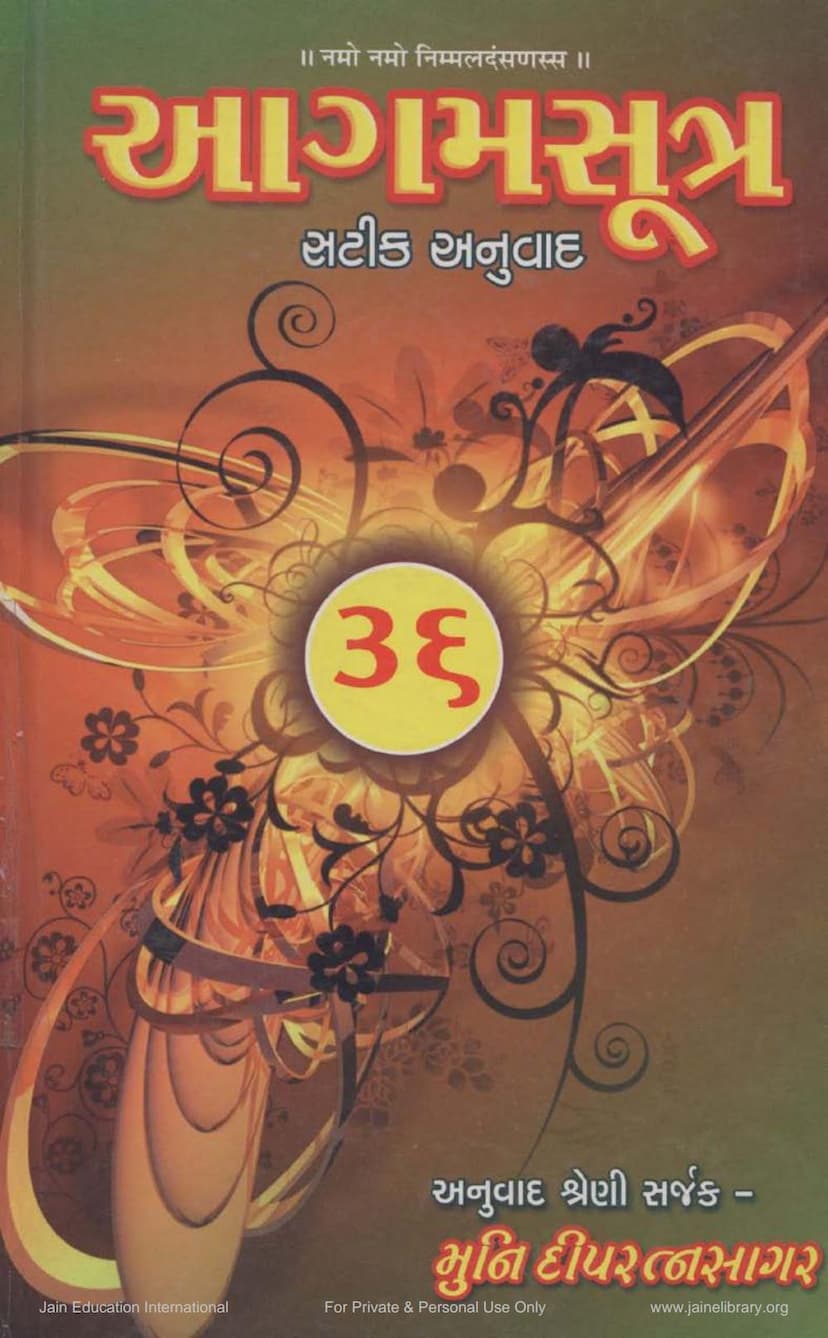Agam 42 DashVaikalik Sutra Satik Gujarati Anuvad
Added to library: September 1, 2025

Summary
This is a comprehensive summary of the Jain text, Agam 42, DashVaikalik Sutra Satik Gujarati Anuvad, authored by Dipratnasagar and published by Deepratnasagar, based on the provided pages.
Overall Purpose and Content:
The text is the 36th part of a larger series of 42 volumes of Agam Sutras with commentaries and Gujarati translations. Specifically, this volume (Part 36) contains the DashVaikalik Sutra, covering its original text (mool), with a detailed commentary and translation. It comprises 10 chapters (adhyayan) and 2 supplementary sections (chulika). The DashVaikalik Sutra is fundamental to Jainism, primarily focusing on the conduct and discipline of ascetics (shramans). It was composed by Acharya Shyyambhav Suri for his son, Muni Manchha Muni, to guide him in the ascetic way of life. The text is considered vitally important for the daily routine and ethical guidelines of monks and nuns.
Key Features and Structure:
- Title: Agam 42 DashVaikalik Sutra Satik Gujarati Anuvad (Agam 42: DashVaikalik Sutra with Commentary and Gujarati Translation)
- Author: Muni Deepratnasagar
- Publisher: Deepratnasagar
- Volume: Part 36 of a 42-part series.
- Content of this Volume: DashVaikalik Sutra (Chapters 1-10), Chulika 1 and 2.
- Significance: The text is described as essential for understanding the principles of Charankaran Anuyog (the branch of Jain literature dealing with conduct and discipline). It is considered practical and applicable for daily life, offering guidance on behavior, ethics, and spiritual practice.
- Key Themes: The DashVaikalik Sutra is considered to be about Charankaran Anuyog, emphasizing the rules and regulations for leading an ascetic life. It is described as "vitally useful for ascetic life" and contains "Acharadi sutras" (sutras related to conduct). It is also noted that after the yogic culmination (yogodvahan), this sutra is used for the initiation ceremony (upasthapana) for ascetics.
Commentary and Translation:
The volume includes:
- Original Sutras (Mool): The core text of the DashVaikalik Sutra.
- Niryukti: Explanatory notes and indices for the sutras.
- Bhashya: Further explanations and discussions.
- Vritti: A broad commentary, primarily based on the one by Haribhadra Suri.
- Churni: Additional commentary, with mentions of parts from Jinadas Gani's Churni and Acharya Agastyasinh Suri's Churni. The latter is noted as being composed in "prowd Prakrit" and is considered worthy of separate translation.
- Translation: A Gujarati translation of the original text and its commentaries.
Specific Content Highlights from the Beginning of the Text (Pages 18 onwards):
- Mangala (Auspicious Beginning): The text begins with verses invoking auspiciousness, praising Lord Mahavir, and stating the purpose of the commentary.
- Niryukti and Bhashya: The initial pages delve into the meaning of the title "DashVaikalik" (Ten Kalas, or Ten Chapters) and its scriptural classification. It discusses the importance of auspicious beginnings (mangala) in scriptures and the various types of auspicious elements.
- Anuyog: The text explains the concept of Anuyog, classifying it into Charankaran Anuyog, Dharmakathanuyog, Ganitanuyog, and Dravyanuyog. It emphasizes the importance of Charankaran Anuyog in this particular sutra.
- Nichep (Categorization): The concept of Nichep (categorization) is introduced, explaining its application to concepts like "ten" (dash) and "time" (kal).
- Examples and Analogies: The text employs various examples and analogies to illustrate its points, such as the lactating cow, the bee and the flower, the story of Manak Muni, and the importance of proper conduct in relation to worldly matters and spiritual progress.
- Detailed Analysis of Chapters: The initial part of the translation provides a detailed breakdown of the themes and content of the first few chapters, including discussions on:
- Dharmaprashansa (Praise of Dharma): Emphasizing the importance of Dharma in Jainism.
- Dhruti (Steadfastness): Highlighting the need for fortitude in ascetic life.
- Achar (Conduct): Discussing ethical conduct, the importance of proper behavior, and the means to achieve self-control.
- Ahar (Food): Detailing the principles of pure and appropriate food intake for ascetics, including discussions on the types of food to accept and reject.
- The concept of "Shramana": Explaining the qualities and practices of an ascetic.
- The importance of not harming living beings (Jivakaya): Elaborating on the principles of Ahimsa (non-violence) in relation to the six life-forms (jivakaya).
- The purpose of various actions and rules: Explaining why certain rules are in place and their ultimate benefits for spiritual progress.
Editorial and Publication Details:
- Sponsors and Contributors: The initial pages acknowledge numerous individuals, organizations, and trusts that have financially supported this publication, indicating a significant effort in making this ancient scripture accessible.
- Publication Series: The text is part of a larger series of publications by Muni Deepratnasagar, which includes original Agamas, Gujarati translations, commentaries on Agamas, and various other works related to Jain literature, grammar, and rituals. The list of publications highlights the author's extensive work in making Jain scriptures available.
Overall Impression:
The text is presented as a scholarly and devotional effort to bring the teachings of the DashVaikalik Sutra to a wider audience. The detailed commentary and translation aim to provide a deep understanding of the ascetic conduct and ethical principles outlined in this important Jain scripture. The meticulous breakdown of concepts, the inclusion of various commentaries, and the extensive list of financial supporters underscore the dedication and resourcefulness behind this publication.